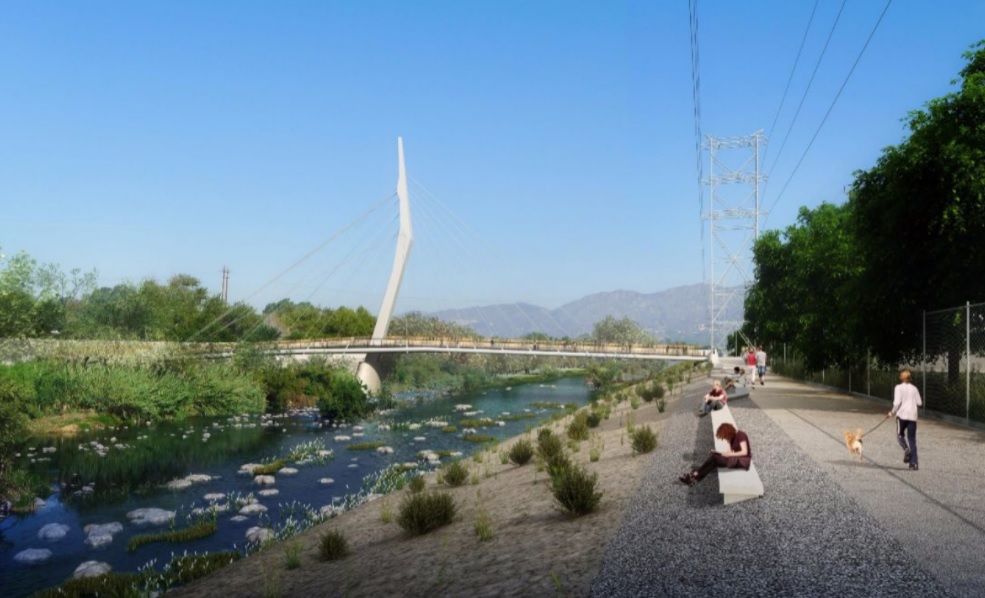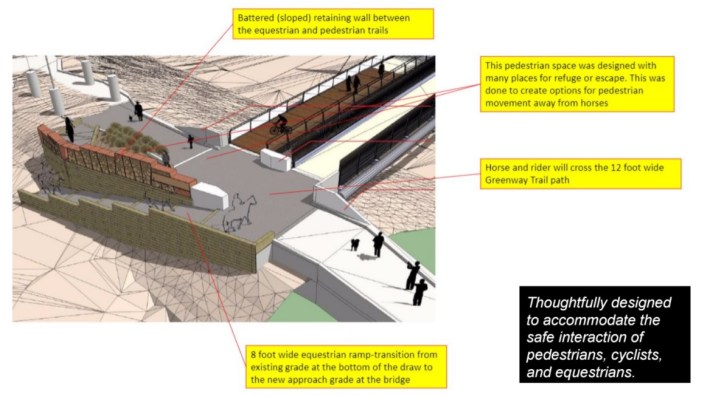L.A. River Atwater Ped-Bike-Horse Bridge Nears Approval
4:12 PM PDT on May 12, 2017

The planned North Atwater multi-modal bridge over the L.A. River. Image via River L.A.
The next few weeks will be crucial to future of a planned innovative North Atwater Village multi-modal bridge over the Los Angeles River. The shovel-ready $16.1 million project has been permitted, environmentally cleared, and publicly- and privately-funded, but still needs L.A. City Council approval to overcome a funding shortfall. As many L.A. River and shared space projects do, the project has had a bumpy road. It now appears poised for final approval this month.
The bridge would be located about a half-mile north of Los Feliz Boulevard. It would connect the North Atwater Village neighborhood east of the river with Griffith Park west of the river. For a long time and still today, the edge of the Atwater Village neighborhood has been home to numerous horse stables. Today equestrians cross through the L.A. River to get to a 5-freeway underpass that connects to trails in Griffith Park. Sadly, the at-grade crossing through the river is dangerous; so many horses have been injured crossing there that many Atwater equestrians will not cross the river and therefore cannot ride to Griffith Park.
The idea of an equestrian bridge there was floated decades ago. Though the project was touted by City Councilmember Tom LaBonge and included in the city of L.A.'s 2007 L.A. River Revitalization Plan, it was very difficult to fund. Facilities for equestrians are generally not very competitive in transportation or park grant funding processes.
According to Executive Director Omar Brownson, the non-profit River L.A. got involved in the project about seven years ago. From the outset of River L.A.'s involvement, they sought to create shared spaces that bring all kinds of people together at the river. What early on had been conceived as an equestrian-only bridge became a "multi-modal bridge designed to serve the respective needs of folks from the cycling, equestrian, and pedestrian communities."

The bridge's design reflects the shared use by pedestrians, cyclists, and equestrians. The bridge itself includes two separated parallel 12-foot wide spans. The approaches allow for equestrians to see and share space with pedestrians and cyclists.
River L.A. sought and obtained private funding for the project. Donor Morton La Kretz committed nearly $5 million in funding for project development and construction. River L.A. intended to build the project as a public-private partnership; they would get the bridge built and the city would take over maintenance.
River L.A. did the work of designing, permitting, and environmentally-clearing the bridge project. These were no small feats given the multi-jurisdictional tangle of the L.A. River being subject to federal, state, county, and city agencies and regulations. The design, above, is a cable-stayed bridge that is not only handsome and distinctive, but minimizes the bridge's impact on river hydrology.
River L.A. applied for funds under the 2014 round of California Active Transportation Program (ATP). The project was approved for $3.66 million toward an anticipated $9.6 million budget. With additional funding from Council District Four, County Supervisor District Three, LADWP, and the California Community Foundation, River L.A. was confident that they had obtained the necessary funds and were set to build the bridge.
In the first round of ATP funding, non-profits had been eligible to seek the state grants. Unfortunately, though the state had awarded funds to River L.A., after a lengthy negotiation, Caltrans administratively determined that the grant funding could not go to a non-profit. To receive the state funding, River L.A. would have to work with a governmental partner. River L.A. was able to transition the already funded project to the city of Los Angeles Bureau of Engineering (BOE).
With a couple years delay, the city in charge of the bridge, and a tightened construction market, project construction costs increased significantly. By the time the city had received bids late last year, the bridge construction cost now came in at $12.5 million, with additional city contingency and city staff costs bringing the total budget to $16.1 million.
Facing a $6+million shortfall, the City Council Arts, Parks, and River Committee requested that the BOE consider a cheaper prefabricated bridge only for equestrians. According to the city staff report, the overall cost for the single-purpose bridge would be $8.2 million for construction, and a total project budget of $11.4 million. Though $11.4 million is cheaper than $16.1 million, the funding picture and the functionality are very different. A single-function equestrian bridge is likely to be used by some pedestrians and cyclists, likely generating conflict. A single-function equestrian bridge would not be able to use $3.6 million in ATP funding nor $3.8 in private donation from La Kretz. Without those funds, the prefabricated bridge would face a funding shortfall of at least $2.9 million. Also, if funded, the prefabricated bridge would need to go through environmental processes and permitting, which are already complete for the cable-stayed design. City staff estimate that this process would likely add at least two years to prefabricated bridge, compared to the shovel-ready multi-modal bridge.
In order to make up the shortfall, deputy mayor Barbara Romero proposed $6.9 million in funding from a little known funding source: Transportation Development Act Article 3 funds. California TDA Article 3 monies come are distributed on a per capita basis. The state disburses these funds to Metro to be distributed to cities. The TDA funding is dedicated to planning and constructing pedestrian and bike projects. L.A. receives a few million dollars of TDA funds each year, and often uses the money as matching funds for grant-funded bike/ped projects.
On May 1st, the Arts, Parks and River Committee approved moving forward to bridge construction, including using TDA, ATP, and La Kretz private funding. Though several speakers testified in favor of the project, some equestrian groups - including the city's Equestrian Advisory Committee - are now pushing for the cheaper prefabricated equestrian-only bridge.
With one committee approval in hand, the multi-modal bridge project still needs to be approved by the Transportation and Public Works Committees, and then the full L.A. City Council. If approved by the council this month, construction would begin this summer, with a new bridge targeted to be open to the public around September 2019.
River L.A. is encouraging North Atwater Bridge supporters to sign an on-line petition.
Stay in touch
Sign up for our free newsletter
More from Streetsblog Los Angeles
Brightline West Breaks Ground on Vegas to SoCal High-Speed Rail
Brightline West will be a 218-mile 186-mile-per-hour rail line from Vegas to Rancho Cucamonga - about 40 miles east of downtown L.A. - expected to open in 2028
This Week In Livable Streets
Active Streets Mission-to-Mission, LAPD reports on its use of force in 2023, Pasadena Transit plans, Metro subway construction, and more
Eyes on the Street: Santa Monica Connection from E Line Bike Path to Downtown Is Almost Complete
“Always be closing gaps in your bikeway network.”




